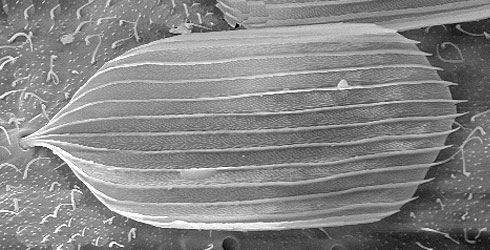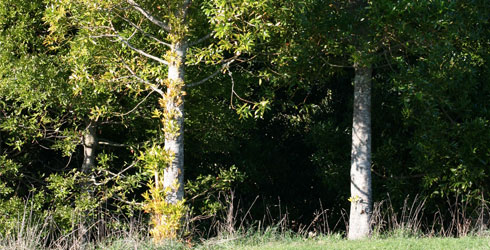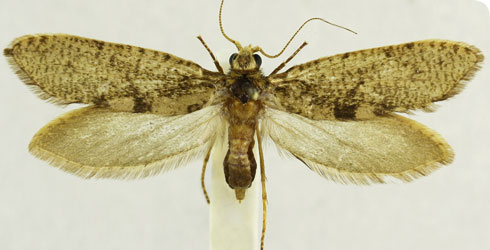Agathiphaga vitiensis (Fiji kauri moth)
The Fiji kauri moth, Agathiphaga vitiensis, is found in the south western Pacific from Fiji in the east through Vanuatu and the New Hebrides to the Solomon Islands in the north and New Caledonia in the west.

Pacific Kauri Pine, Agathis macrophylla.
Kauri moths are medium-sized micro moths with a wingspan up to 27mm. The adults are brownish with a broad head and slender antennae.
They rest with their wings held roof-like over the body and have a distinctive caddis fly-like appearance.
Infestations of Kauri moth larvae in Kauri pine cones can sometimes reach pest levels and have negative effects on commercial production of Kauri timber - especially Pacific Kauri, Agathis macrophylla, on Fiji and the Solomon Islands.
The Museum has played an important role in studies of Agathiphaga vitiensis. Our current micro Lepidoptera curator Mr Kevin Tuck, and Museum scientist the late Dr Gaden S Robinson, raised a number of adult specimens from infested Kauri seeds in the 1970s.
This unique material has formed the basis for several important studies carried out by international researchers in several countries.
Species detail
Agathiphaga vitiensis, is 1 of 2 species in the genus Agathiphaga. The other is the Australian kauri moth - A. queenslandensis, from Queensland.
The 2 species are the only living representatives of the family Agathiphagidae - one of the most ancient and primitive lineages within the Lepidoptera.
-

Taxonomy
Agathiphaga vitiensis is thought of as a ‘living fossil’. Find out how its primitive morphology has helped scientists explore the evolution of moths and caddis flies.
-

Distribution and habitat
Agathiphaga vitiensis larvae live on Kauri pine trees, but only in some parts of the world. Find out where.
-

Biology
This moth is rarely encountered in its natural habitat. It is nocturnal and lays its eggs in the seeds of pine cones. Find out what else we know about this moth’s lifestyle and how it can remain dormant for up to 12 years.
-

References
Get reference material for Agathiphaga vitiensis.
Images

Wing scales from primitive Lepidoptera. The specialised wing vestiture in Agathiphaga with deeply notched cover scales - indicated with the arrow.

Wing scales from primitive Lepidoptera. An ordinary scale from the family Micropterigidae.

Pacific Kauri pine, Agathis macrophylla.

Heads of two primitive moths showing diffrent mouthparts.
Left: Micropterix calthella with biting mandibles - indicated with the arrows. (Modified from Hannemann, 1956)
Right: Dyseriocrania griseocapitella with a proboscis - indicated with the arrow. (Modified from Davis, 1978)

Agathiphaga vitiensis larva in Agathis seed (from Kristensen 1998).
About the author
A word from the author
'The 2 Agathiphaga species are amongst the most extraordinary and scientifically important species of Lepidoptera - not a bad accomplishment given that there are more than 150,000 named Lepidoptera species in the world!
Their importance stems partly from their isolated position near the base of the Lepidoptera evolutionary tree, and partly from the fact that their morphology and anatomy is an incredible mixture of very ancient, primitive traits with very advanced, unique traits.
Two NHM lepidopterists, Gaden S Robinson and Kevin Tuck, are the only lepidopterists in the world to rear a number of moths from infested seeds in the 1970s and have given researchers all over the world an invaluable source of well preserved material for detailed studies which would otherwise have been impossible.'
Toolbox
Glossary
Diapause
A mechanism used by many arthropods to survive predictable, unfavourable environmental conditions, such as temperature extremes, drought or reduced food availability.

